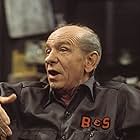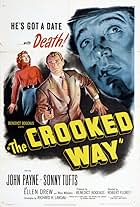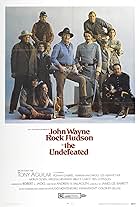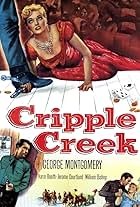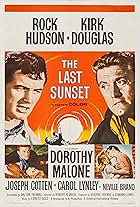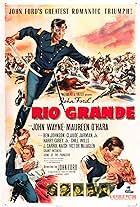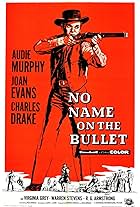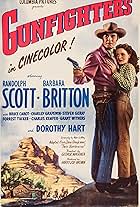Before the U.S. Civil War rebel leader Luke Darcy sees himself as leader of a new independent Republic of Kansas but the military governor sends an ex-raider to capture Darcy.Before the U.S. Civil War rebel leader Luke Darcy sees himself as leader of a new independent Republic of Kansas but the military governor sends an ex-raider to capture Darcy.Before the U.S. Civil War rebel leader Luke Darcy sees himself as leader of a new independent Republic of Kansas but the military governor sends an ex-raider to capture Darcy.
Al Wyatt Sr.
- Jayhawker
- (as Allan Wyatt)
Max Trumpower
- Governor's Aide
- (as Max Power)
Storyline
Did you know
- TriviaThe theme for TV's Wagon Train (1957) was taken directly from the Jerome Moross score of this film when Moross worked on the western series.
- GoofsTopeka is referred to as the Capitol of Kansas, during the time period depicted in the film, prior to the Civil War, the capitol of the Kansas Territory was actually Lecompton.
- Quotes
Luke Darcy: I've got what I want. I've got Kansas.
- ConnectionsReferenced in Mission: Impossible: The Mind of Stefan Miklos (1969)
Featured review
Shortly before the start of the American Civil War rebel Kansas leader Luke Darcy (Jeff Chandler) plans a new independent Republic of Kansas and craving for loot . His vigilante group is called The Jayhawkers and their depredations contributed to the descent of the Missouri-Kansas border region into some of the most vicious guerrilla fighting of the Civil War. Their mission is to end slavery by force but degenerating so completely into a squalid, murderous, slugging match . However, rebel leader Darcy uses The Jayhawkers for his own bid for absolute control of Kansas. Darcy's actions do not sit well with the military governor of Kansas, William Clayton (Herbert Rudley) , as the government command instituted martial law due to "the crime of armed depredations or jay-hawking having reached a height dangerous to the peace and posterity to the whole State (Kansas) and seriously compromising the Union cause in the border counties of Missouri. As William Clayton supposedly wants Darcy captured and brought to justice. For this aim the governor hires an ex-renegade rebel , Cam Bleeker (Fess Parker) , to join Darcy's group and capture their leader . Bleeker has a personal reason for wanting to see Darcy hanged and he's craving for revenge . Darcy was responsible for Bleeker wife's death while Bleeker was in prison .
Exciting film inspired by historical facts set during pre-American Civil War (1861-1865) in which the Jayhackers use guerrilla warfare to destroy targets and led by men set on revenge, invading peaceful towns , making violent raids in Kansas territory . The picture efficiently describes the atmosphere of violence and confrontation among bands and bloody assaults . Stars the known hero Fess Parker-pre Daniel Boone- as the ex-con and an ex-raider whom the military governor sends to capture Darcy well played by Jeff Chandler . Along with this excellent duo there are various notorious actors and familiar faces accompanying them such as : Nicole Maurey , Henry Silva , Herbert Rudley , Frank DeKova , Don Megowan , Leo Gordon , Jack Kruschen , Glen Stange , and Harry Dean Stanton. The motion picture was well directed by Melvin Frank.
The picture was based on historical events , these were the following ones : Jayhawkers and red legs are terms that came to prominence in Kansas Territory, during the Bleeding Kansas period of the 1850s ; they were adopted by militant bands affiliated with the free-state cause during the American Civil War . These gangs were guerrillas who often clashed with pro-slavery groups from Missouri, known at the time in Kansas Territory as "Border Ruffians" or "Bushwhackers." After the Civil War, the word "Jayhawker" became synonymous with the people of Kansas, or anybody born in Kansas. Today a modified version of the term, Jayhawk, is used as a nickname for a native-born Kansan. The meaning of the jayhawker term evolved in the opening year of the American Civil War. When Charles Jennison, one of the territorial-era jayhawkers, was authorized to raise a regiment of cavalry to serve in the Union army, he characterized the unit as the "Independent Kansas Jay-Hawkers" on a recruiting poster. The regiment was officially termed the 7th Regiment Kansas Volunteer Cavalry, but was popularly known as Jennison's Jayhawkers. Thus, the term became associated with Union troops from Kansas. After the regiment was banished from the Missouri-Kansas border in the spring of 1862, it went on to participate in several battles including Union victories of the Battle of Iuka and the Second Battle of Corinth. Late in the war, the regiment returned to Kansas and contributed to Union victory in one of the last major battles in the Missouri-Kansas theater, the Battle of Mine Creek. The Jayhawker term was applied not only to Jennison and his command, but to any Kansas troops engaged in punitive operations against the civilian population of western Missouri, in which the plundering and arson that characterized the territorial struggles were repeated, but on a much larger scale. For example, the term "Jayhawkers" also encompassed Senator Jim Lane and his Kansas Brigade, which sacked and burned Osceola, Missouri. In the first year of the war, much of the movable wealth in western Missouri had been transferred to Kansas, and large swaths of western Missouri had been laid waste, by an assortment of Kansas Jayhawkers ranging from outlaws and independent military bands to rogue federal troops such as Lane's Brigade and Jennison's Jayhawkers. In February 1862, the Union command instituted martial law due to "the crime of armed depredations or jay-hawking having reached a height dangerous to the peace and posterity to the whole State (Kansas) and seriously compromising the Union cause in the border counties of Missouri.
Exciting film inspired by historical facts set during pre-American Civil War (1861-1865) in which the Jayhackers use guerrilla warfare to destroy targets and led by men set on revenge, invading peaceful towns , making violent raids in Kansas territory . The picture efficiently describes the atmosphere of violence and confrontation among bands and bloody assaults . Stars the known hero Fess Parker-pre Daniel Boone- as the ex-con and an ex-raider whom the military governor sends to capture Darcy well played by Jeff Chandler . Along with this excellent duo there are various notorious actors and familiar faces accompanying them such as : Nicole Maurey , Henry Silva , Herbert Rudley , Frank DeKova , Don Megowan , Leo Gordon , Jack Kruschen , Glen Stange , and Harry Dean Stanton. The motion picture was well directed by Melvin Frank.
The picture was based on historical events , these were the following ones : Jayhawkers and red legs are terms that came to prominence in Kansas Territory, during the Bleeding Kansas period of the 1850s ; they were adopted by militant bands affiliated with the free-state cause during the American Civil War . These gangs were guerrillas who often clashed with pro-slavery groups from Missouri, known at the time in Kansas Territory as "Border Ruffians" or "Bushwhackers." After the Civil War, the word "Jayhawker" became synonymous with the people of Kansas, or anybody born in Kansas. Today a modified version of the term, Jayhawk, is used as a nickname for a native-born Kansan. The meaning of the jayhawker term evolved in the opening year of the American Civil War. When Charles Jennison, one of the territorial-era jayhawkers, was authorized to raise a regiment of cavalry to serve in the Union army, he characterized the unit as the "Independent Kansas Jay-Hawkers" on a recruiting poster. The regiment was officially termed the 7th Regiment Kansas Volunteer Cavalry, but was popularly known as Jennison's Jayhawkers. Thus, the term became associated with Union troops from Kansas. After the regiment was banished from the Missouri-Kansas border in the spring of 1862, it went on to participate in several battles including Union victories of the Battle of Iuka and the Second Battle of Corinth. Late in the war, the regiment returned to Kansas and contributed to Union victory in one of the last major battles in the Missouri-Kansas theater, the Battle of Mine Creek. The Jayhawker term was applied not only to Jennison and his command, but to any Kansas troops engaged in punitive operations against the civilian population of western Missouri, in which the plundering and arson that characterized the territorial struggles were repeated, but on a much larger scale. For example, the term "Jayhawkers" also encompassed Senator Jim Lane and his Kansas Brigade, which sacked and burned Osceola, Missouri. In the first year of the war, much of the movable wealth in western Missouri had been transferred to Kansas, and large swaths of western Missouri had been laid waste, by an assortment of Kansas Jayhawkers ranging from outlaws and independent military bands to rogue federal troops such as Lane's Brigade and Jennison's Jayhawkers. In February 1862, the Union command instituted martial law due to "the crime of armed depredations or jay-hawking having reached a height dangerous to the peace and posterity to the whole State (Kansas) and seriously compromising the Union cause in the border counties of Missouri.
- How long is The Jayhawkers!?Powered by Alexa
Details
- Runtime1 hour 40 minutes
- Aspect ratio
- 1.85 : 1
Contribute to this page
Suggest an edit or add missing content



















